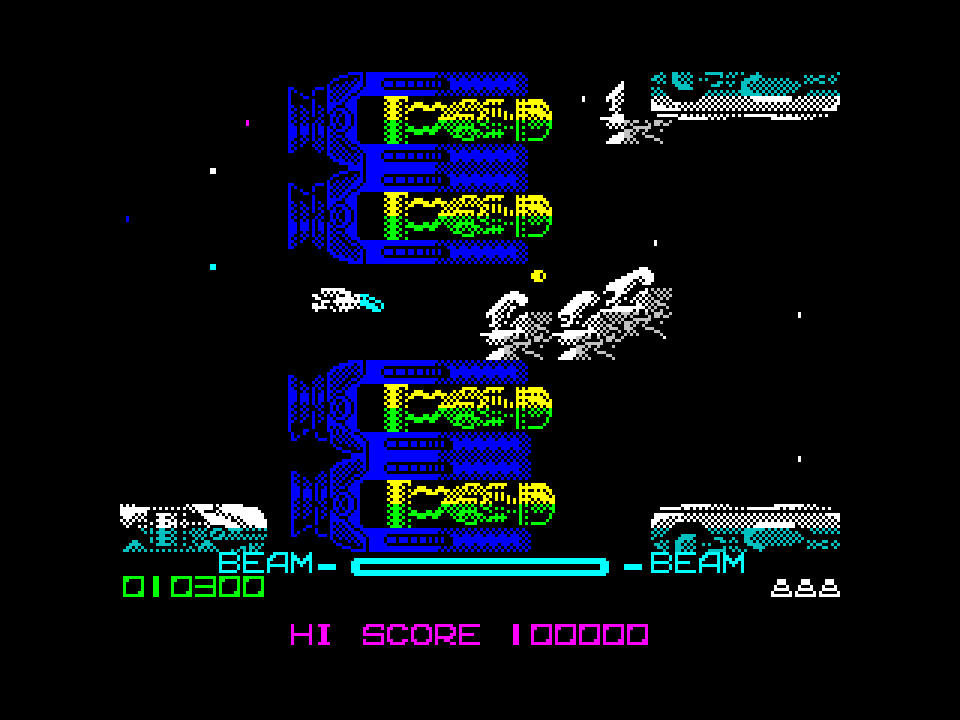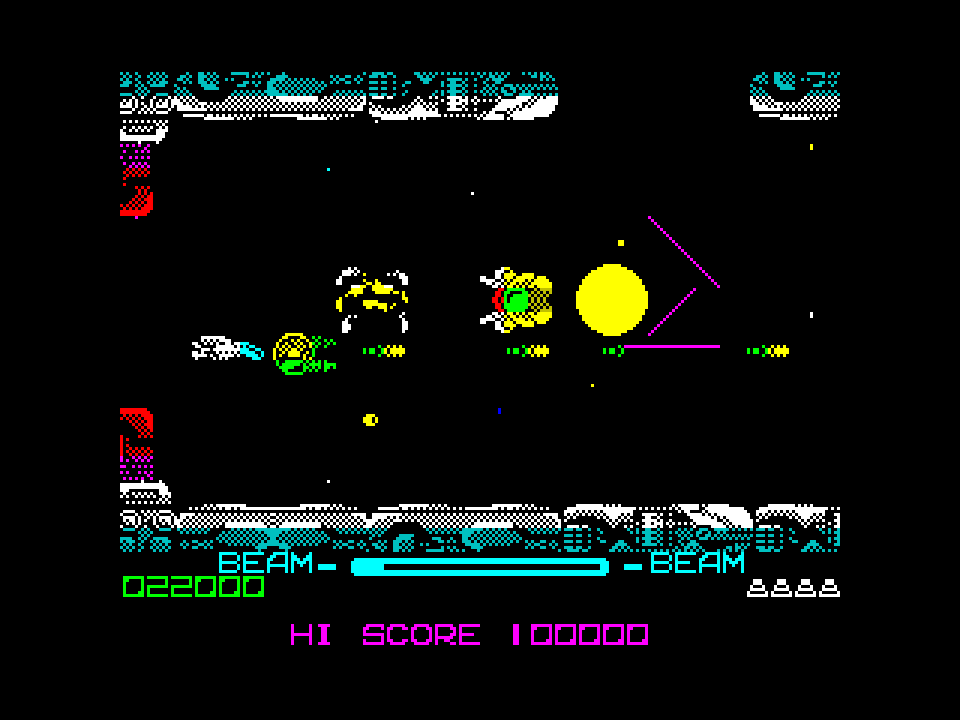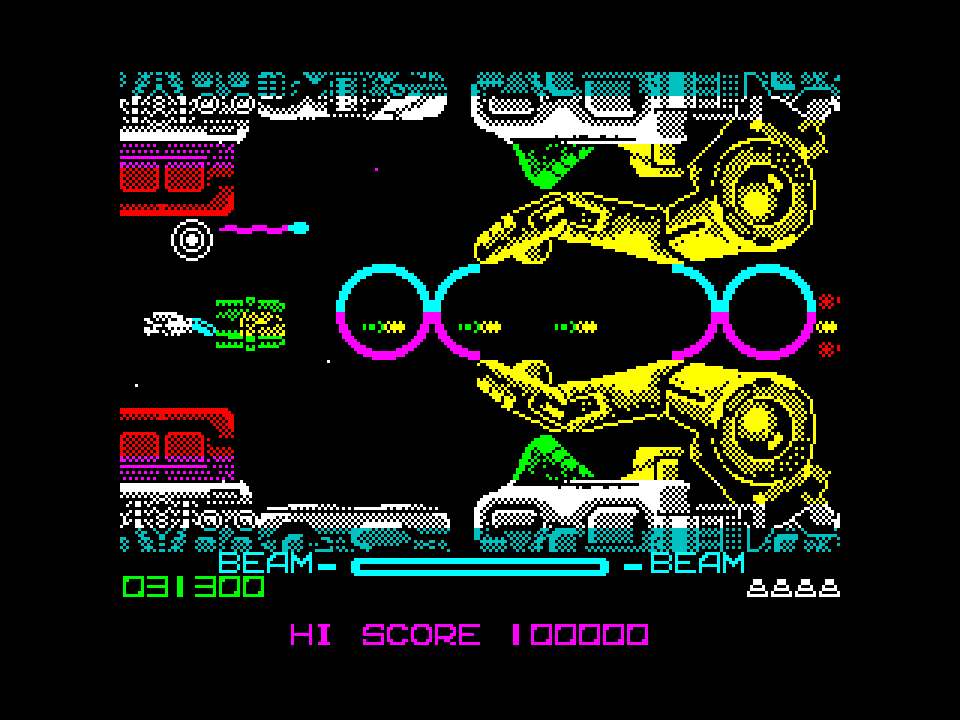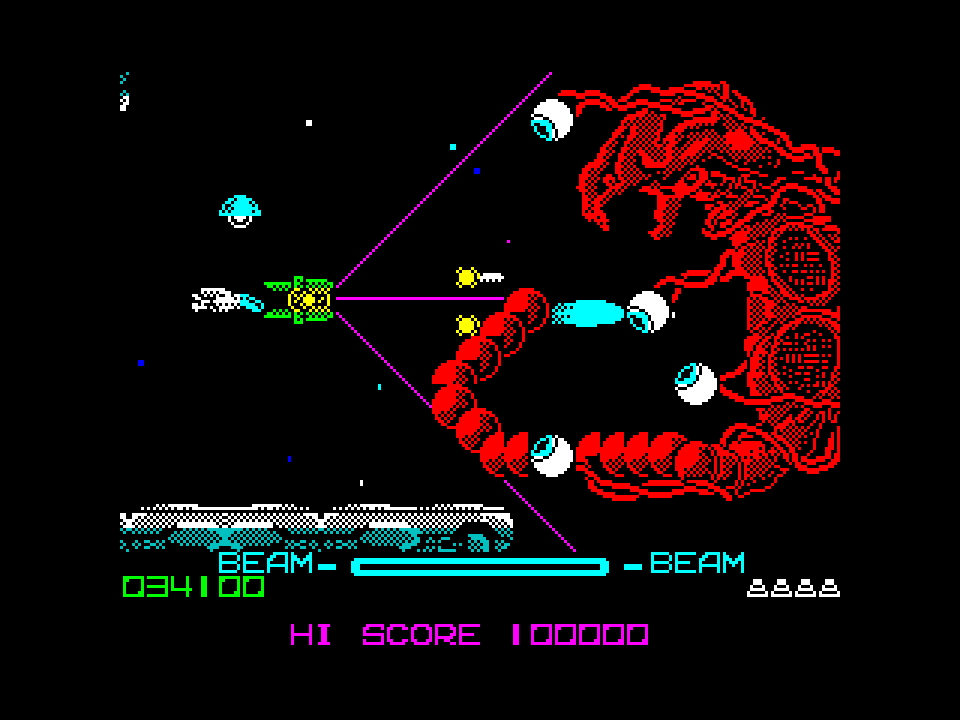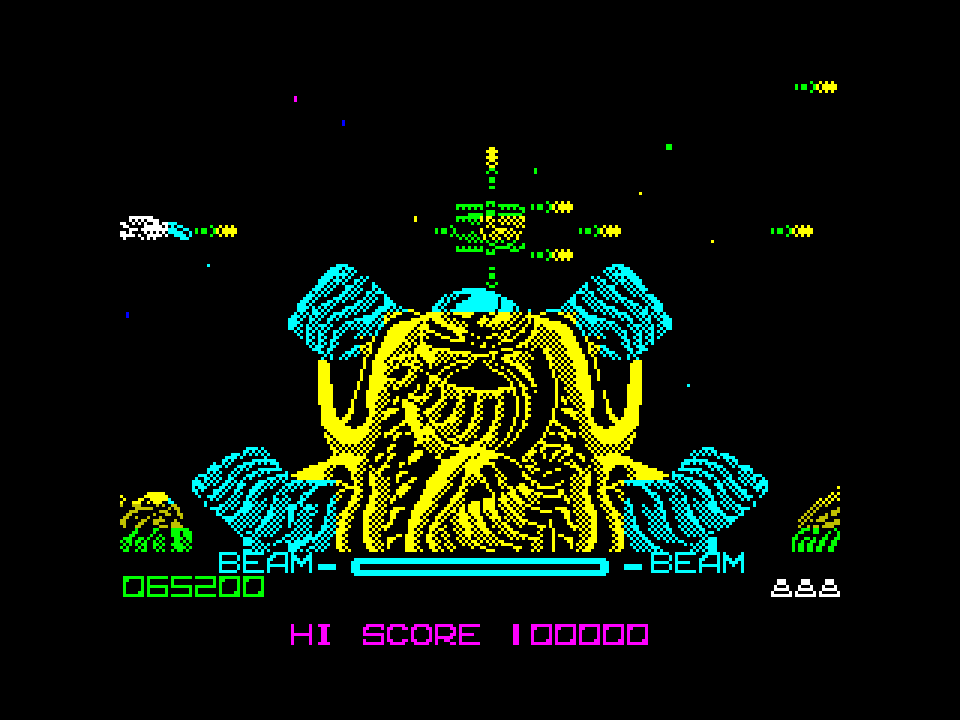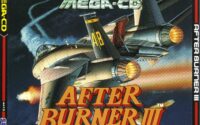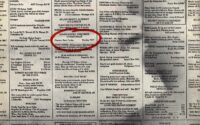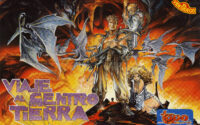R-Type Review
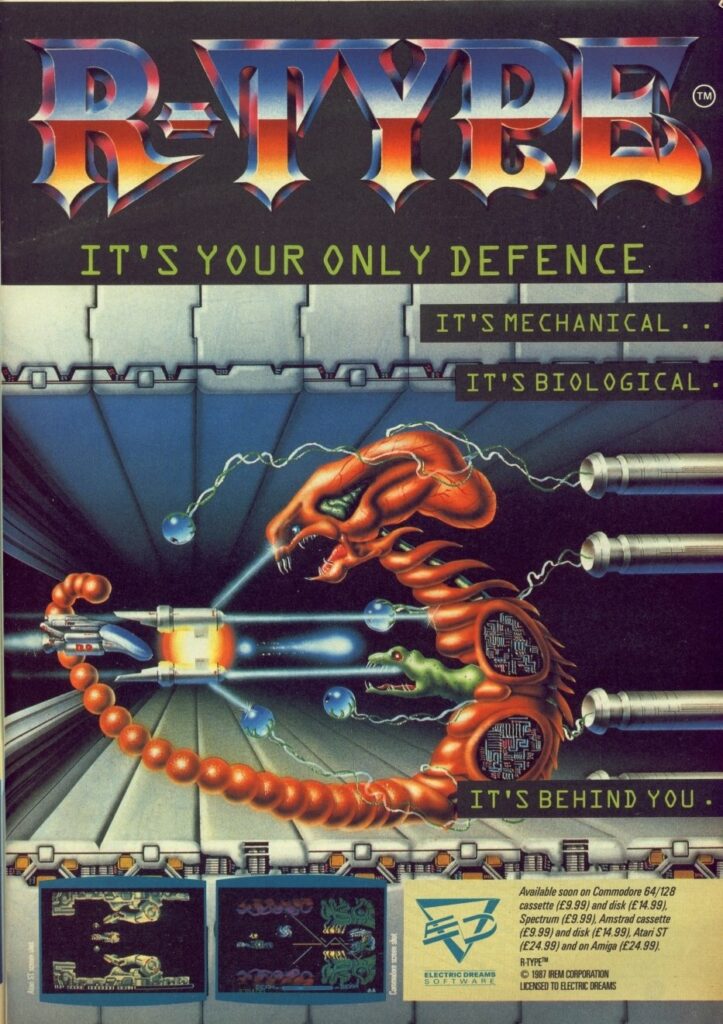
We just have to…
You can’t talk about the ZX Spectrum without mentioning the port of R-Type in detail. It just can not be done.
STORY
The Speccy in original 48K mode can’t be accused of being any kind of go-to machine for fast paced and breath-taking Shmup action. (Not that there were endlessly many platforms to choose from in the 80s, but some of them simply were better.) But in the case of the Spectrum, it was all about those sudden surprises – Big and small.
Does a game like, for example, Chronos: A Tapestry Of Time have its place in this world? Absolutely. While the Radical Tubes’ game wasn’t the finest Shoot ‘Em-Up in existence, it had one of these major elements of surprise: Tim Follin’s title screen-tune. And then, there’s a game like Crosswize – Raw as few. And hard as a son of a bitch. But it has some serious charm and includes the best of both worlds – Nice visuals and maniacal blasting. Xecutor is another warmly talked about Shmup that even has simultaneous two-player action and surprisingly colorful graphics…
I have no idea for how long the list goes on… But the list goes on…
Still, do we need to play every horizontally scrolling Shoot ‘Em-Up in existence to find a bunch that are the best of the best for each platform? No. We already know that they mostly are about controlling a space-ship and shooting bullets. (Preferably at enemies that behave more or less irrationally.) But it’s the other qualities that we want to know about. Gameplay. Features. Power-ups. The number of levels.
And sometimes came a Coin-Op port like R-Type for Sinclair’s machine… No, scratch that. It essentially was a once in a lifetime deal. A brief moment in history where it all wasn’t just a day at work for the developers, but where passion took over – The desire to make something extraordinary. (And add “Accuracy” to the aforementioned qualities.)
Before you do anything else – Ask yourself a very important question: “Have I played the original arcade version of Irem’s ground-breaking Shmup?” If not. Do so. (Then, check out the Commodore 64 version! Listen to that soundtrack by Chris Hülsbeck. And check out his intro-tune on the Amiga while you’re at it.) And if you don’t have the arcade machine in your living room, or the ROM for the MAME-emulator, there are a couple of platforms to choose from in this day and age. (R-Type is even available for the iPhone now…)
But now, it’s time to insert that virtual ZX Spectrum cassette and load up:
THE GAME
Love may not be in the air, but love is in the space and in the pixels that the Speccy fires onto the screen while R-Type runs…
Pictures should mostly talk for themselves… But in case you missed it – R-Type is a Shoot ‘Em-Up. It scrolls horizontally from right to left and has eight levels. You control the “Arrowhead”, a.k.a. R-Type 9 in order to blast the Bydo Empire and its inhabitants to small pieces. Most levels have a boss at the end, except Level 3, where you encounter one big ass space-ship.
Apart from your ordinary blaster, you can hold down the Fire-button to charge up a plasma beam. The longer you hold Fire, the more powerful the beam gets. (With an obvious maximum capacity. The force of the beam is displayed on-screen as a horizontal gauge.) By shooting the pods that frequently appear throughout the levels, you can upgrade the R-9 with an orb that can be attached to the front or the back of the vessel. When detached, the orb fires when you fire. (Additionally, it has multi-directional fire and it shoots backwards and protects your ass when it’s attached to the rear.) The other upgrades include homing missiles, Reflection Laser, Ripple Laser, a protective satellite, speed-up, and shield. (Compared to the arcade version, almost every single weapons upgrade made it to the Spectrum.)
CONTENT
This port is nothing short of a miraculous effort. I have no idea how Bob Pape and Mark “Mak” Jones from Software Studios crammed in nearly everything from the original, but here it is – As accurately as a Spectrum ever could imitate something powerful like a Coin-Op.
Someone who doesn’t know anything about “8-bit”-computers but is familiar with R-Type might see this game and wonder what the deal is with a conversion that doesn’t have particularly smooth scrolling or smooth action. And one might wonder how much “R-Type” a port is where objects sometimes clash and half-disappear in jerky motion when the “screen update”-code obviously can’t handle it as well as it was intended. This happens during the more intense sweat-breaking moments. Because you die if you don’t blast like a maniac.
But. As usual, one has to be as fair as possible and look at the whole deal from a technical point of view. I believe that the Z80 CPU @ 3.5 MHz handled this particular game as well as it ever could and that the programming is a definition of Tour De Force. Could it have been even more optimized? Who knows? Probably not very.
R-Type is a multi-load affair. Thankfully. It’s already impressive that ONE level fit into 48 KB, but since the developers made the extra-extra effort to convert as much as of the visuals as closely as possible, it’s a good thing that the levels load separately. The game doesn’t have a 128K mode, so it can’t hold several levels in memory at once. (And reportedly, there was never any disk version produced.)
CONTROLS
Your options are the Kempston Interface or keys. These are defined by the player, and apart from the four directions and the Fire-button, there is also a key for “Detach”. The weapon orb attaches itself automatically to R-9 upon contact, just like in the original.
GRAPHICS
It’s quite amazing how not even a dozen colors can look like so many more. The sprites and parts of the backgrounds are obviously single-colored, but the pixel-work regarding the shading and level of detail is amazing. The game could have been in solid black and white and it still would have looked good, but color has been used wherever it was possible. Even the R-9 is in two colors. (And the Ripple Laser looks fuckin’ perfect!)
As mentioned, the scrolling isn’t what anybody would call “smooth”. And the frame-rate stutters at times. But this is quite easy to look past when you realize how playable this version actually is. (It’s hard, just like the arcade. And it’s more enjoyable than some other ports – None mentioned, none forgotten.) Some sprite-flickering and glitches were probably impossible to circumvent as well.
And if you print out and frame loading screens from various Spectrum games, you could easily print out the one for R-Type.
SOUND
This would be the absolutely weakest link in the chain. That 128K mode is desperately missed… You only get a few simple tunelets and a cacophony of pops, crunches, beeps, and distorted noises during the game. No music. Robert Hylands programmed the sound, and while you have heard better sounds in 48K games, it’s better than nothing… Ish… You could always have something more recent “R-Type”-related playing in the background while playing, for example, the soundtrack from R-Type Dimensions or the tunes from the C64 version. Blasphemy? Not when it’s an option that’s light years better.
SUMMARY
Software Studios were behind Spectrum ports of classics like Afterburner, Power Drift, Super Hang-On, and while they fluctuated in quality on the good side of things (Check out Super Hang-On, at least!), the developers outdid themselves with R-Type. This is a work of art. And this version should not have been possible to re-create during given circumstances. Obviously, magic was involved. Or just amazing coding- and pixel-painting skills.
For an R-Type fan, this version can only be highly recommended as a curiosity. It shows what the Spectrum could do, and it should be interesting to experience the differences between as many versions as possible. For a fan of Shmups in general, the argument should be similar – Play as many of them as possible on as many platforms as possible. You will find a fave.
And someone who dismisses this port for not being arcade perfect, ultra-fast, or whatever, there’s just one hard truth remaining – That some people have extremely unrealistic expectations.
Developed by: Software Studios
Published by: Electric Dreams Software
Version Reviewed: ZX Spectrum 48K
Genre: Shoot ‘Em-Up
Players: 1
Also Available On: Commodore 64, Commodore Amiga, Arcade, SEGA Master System, MSX, etc.
Released: 1988

